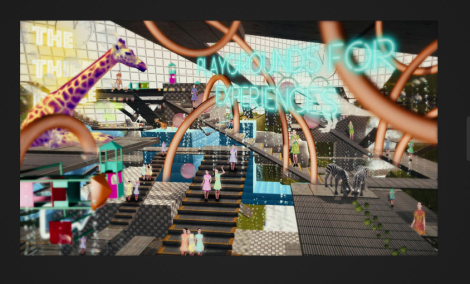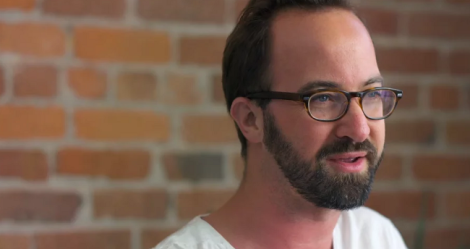
The Problem with VR (and why Google’s Tilt Brush provides valuable lessons for any VR company)
You’ve seen the photo. Whenever there is an article about virtual reality now the hero photo will inevitably be one of a man or woman with a VR headset staring off into the Netherland smiling (or laughing) at something you the viewer can’t see and can only guess.
It looks …odd. “What’s s/he looking at?” Slightly hyper and…well sort of cliche.
It also does VR no favors.
Problems Selling VR
I had a friend tell me the other day she knew nothing about VR, had never tried it but she suspected it would make us all into“zombies”. She’s not alone.
If you read any tech media over the last few months you’ll recognize this pic.
Posted by Mark Zuckerberg at the Mobile World Congress in Spain in February when the photo was first published articles erupted calling VR “concept art for a new dystopian sci-fi film”. Another article called it “creepy” and comments were made on the Facebook post by people saying “I don’t want to live in a world like this” and that it showed a “future of zombies”.
In short it was a mini PR #fail for the VR ‘industry’ as a whole.
And the fact the photo was posted by Facebook’s founder — one of the biggest investors into VR at the moment (via the Oculus) didn’t help either.
As someone who works in VR I’m fascinated with why this photo was so negatively received. I believe there is a lot to be learned from this photo from those working in the VR so that the same mistakes aren’t made in communicating the potential of VR platforms, games, VR content or hardware.
[BTW- I would love to see a consumer psychologist break this photo down into why it led to such a negative consumer feedback when it first appeared. Any takers?!]
Some of the elements that come to my mind when I first looked at this photo were:
- Visual arresting — the photo is visually arresting which is sort of an advertising 101. But its “visual arresting” for all the wrong reasons. Rows and rows of men all dressed similarly in suits and white shirts and all staring vacantly into space is not engaging, does not invite the viewer into the potential experience. Truth is most people don’t know about VR, have never tried it and don’t care about it (especially with current VR hardware price-tags). Communicating the potential of VR becomes easier when people experience it for themselves but to get people to this point requires making them want to experience it. And a photo of VR where people look like a factory line of robotic consumers is not captivating.
- Include don’t exclude people — When I first saw the picture I felt excluded. Why? Well for a start. It’s predominately if not all men in the photo. As a woman this makes me feel that VR’s main target market is not me — a woman – which of course is not true. Yes it’s true that VR at the moment is predominantly being shaped by men simply by virtue of the fact that more men than women work in VR. Hopefully in time this will change but if you are creating a VR platform, content or hardware don’t get caught up in what’s familiar and forget or neglect the needs and preferences of 50% of your potential market — women.
- Articulate clearly the vision and benefit — In the photo everyone is wearing effectively the same clothes — dark suits with shirts — everyone except Zuckerberg. He’s different. The “other”. Dressed in jeans, T-shirt and runners. He’s also not wearing a VR headset so not partaking in the experience but rather seems to controlling it, charging down the middle of the aisle smiling softly. Mark Zuckerberg didn’t plan this it seems. The photo was taken and shared in good faith. But the problem with all this is that it sells the vision of VR as something that enables brands to be in control and the consumers becomes a passive consumer of the experiences dished up to them. And the benefit? Well there doesn’t seem to be any to the viewer because as a viewer of the photo I can’t see what they audience are experiencing so I am locked out of the potential wonder or awe of their experience.
Tilt Brush Lessons
So what companies are communicating the vision and benefit of VR clearly at the moment?
Not as many as there could be.
Last week though I saw a short promo from Google’s Tilt Brush and I thought finally VR seems to be on a path to a way to clearly communicate the benefits of a VR experience in a non creepy, non cliche and engaging way.
If you haven’t heard of it, Tilt Brush, lets you paint in 3D space with virtual reality. As the video says “Your room is your canvas. Your palette is your imagination. The possibilities are endless.” [It’s also a free include with pre-orders of the HTC Vive.]
What I like about the promo video though in terms of successfully communicating a VR experience is that it draws the viewer — the spectator — in on the experience also.
It manages to escape feeling voyeuristic or ‘scary’ or that I as a user will become a “zombie” by immersing myself in the experience. The people in the video using VR look active, empowered and enabled. The video in some way normalizes VR and shows how it can enable me as a user to do something I already love doing — creating content.
VR is the medium that is ultimately all about the experience. But at the moment the VR experience is not being communicated as well as it might be to many consumers. And if you work in VR you can’t rely or wait for journalists or the media to do this job. As blogger and community manager Vanessa King pointed out in a recent Medium post:
”There simply aren’t academics or huge companies that can speak to the current state of virtual reality on a quick turnaround”.
Right now the need to effectively communicate the potential and benefit of a VR experience — whether consumer or enterprise focused — to VR newbies is a challenge but a vital first step in the growth of any VR company — and the ‘industry’ per se.
Have you any suggestions of other companies that are doing a great job communicating the experience of VR? Share below.
[Image credit: William Wei, Business Insider ]




